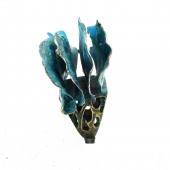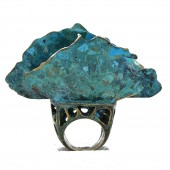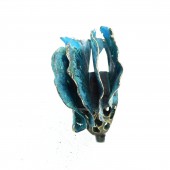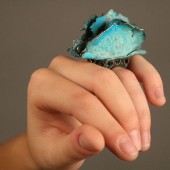Gingko I Ring by Ekaterina Korzh |
Home > Winners > #85874 |
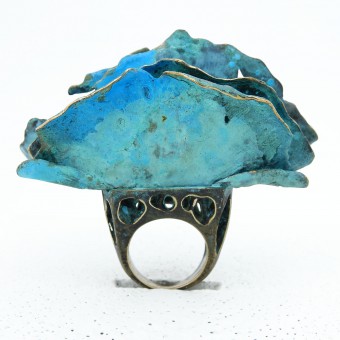 |
|
||||
| DESIGN DETAILS | |||||
| DESIGN NAME: Gingko I PRIMARY FUNCTION: Ring INSPIRATION: As a geographer in the past, I always had a strong inspiration in nature. When I finally found myself in jewelry design and making I found it even easier to present my admiration for nature in my jewelry. This ring consists of several organic features which catch viewers with a beauty of natural shapes of the leaves, trees, ocean, waves, etc. I believe this what creates such a unique feeling of combined motion and equilibrium. This ring is a devotion to Mother Nature. UNIQUE PROPERTIES / PROJECT DESCRIPTION: "Gingko I" ring is the result of my experiment with gingko leaves forms and natural patina of bronze. The base for the ring was carved manually from wax and then being cast in bronze. Four gingko leaves cast in bronze too and they are crowning the top in a sequence which creates a motion feeling. Different shades of blue and green patina finalizing the idea of motion by reminding a viewer about waves of an ocean. OPERATION / FLOW / INTERACTION: This ring is a statement ring which exists to attract attention. Despite its complexity, his ring is easy and comfortable to wear for special occasions and events. PROJECT DURATION AND LOCATION: Iowa City, USA, in 2018 |
PRODUCTION / REALIZATION TECHNOLOGY: The process of creations took around four months. It was made for my brand company during my school practices at the University of Iowa, USA. Materials: bronze, patina SPECIFICATIONS / TECHNICAL PROPERTIES: Dimebssions: 8cm x 7cm x 3,5cm TAGS: ring, gingko, brass, blue, sea, fantazyring, fashionring, statement, green, ocean, patina RESEARCH ABSTRACT: - CHALLENGE: This ring was created by hand using traditional wax carving techniques. The challenge was to carve a unique freeform ring to give it an organic and well-balanced shape. Each branch was carefully carved manually to create a sense of galleries of the tree branches which hold a crown of gingko leaves. The ring should be still made comfortable to wear. However, the biggest research challenge was made during the patination process. It was hard to receive proper colors and textures using chemical reactive and solutions. After several months of experiments, the desired color and pattern was achieved. ADDED DATE: 2019-03-30 20:12:42 TEAM MEMBERS (1) : Ekaterina Korzh IMAGE CREDITS: Ekaterina Korzh, 2018 |
||||
| Visit the following page to learn more: https://www.instagram.com/korzhstudio/ | |||||
| AWARD DETAILS | |
 |
Gingko I Ring by Ekaterina Korzh is Winner in Jewelry Design Category, 2018 - 2019.· Press Members: Login or Register to request an exclusive interview with Ekaterina Korzh. · Click here to register inorder to view the profile and other works by Ekaterina Korzh. |
| SOCIAL |
| + Add to Likes / Favorites | Send to My Email | Comment | Testimonials | View Press-Release | Press Kit |

